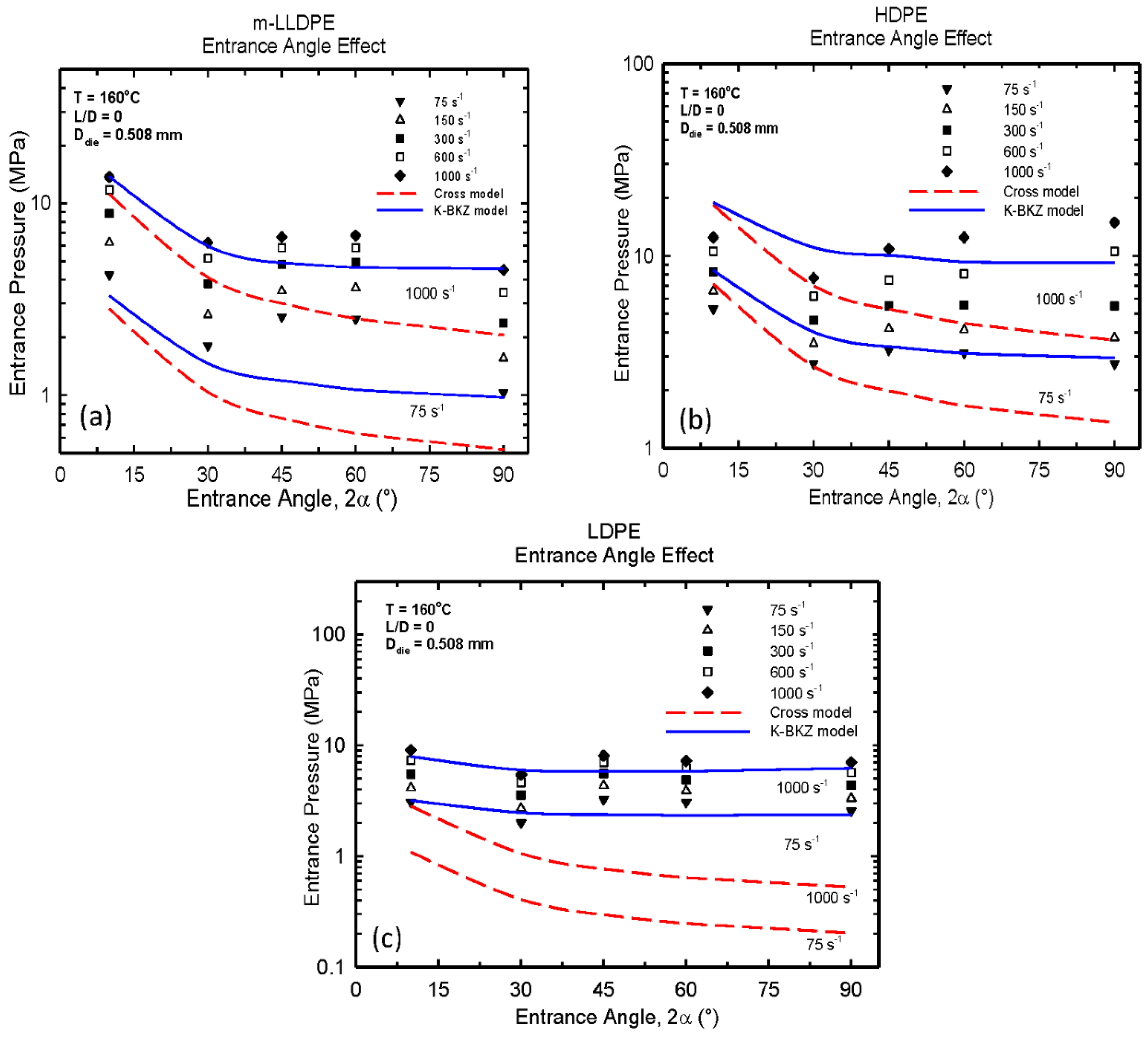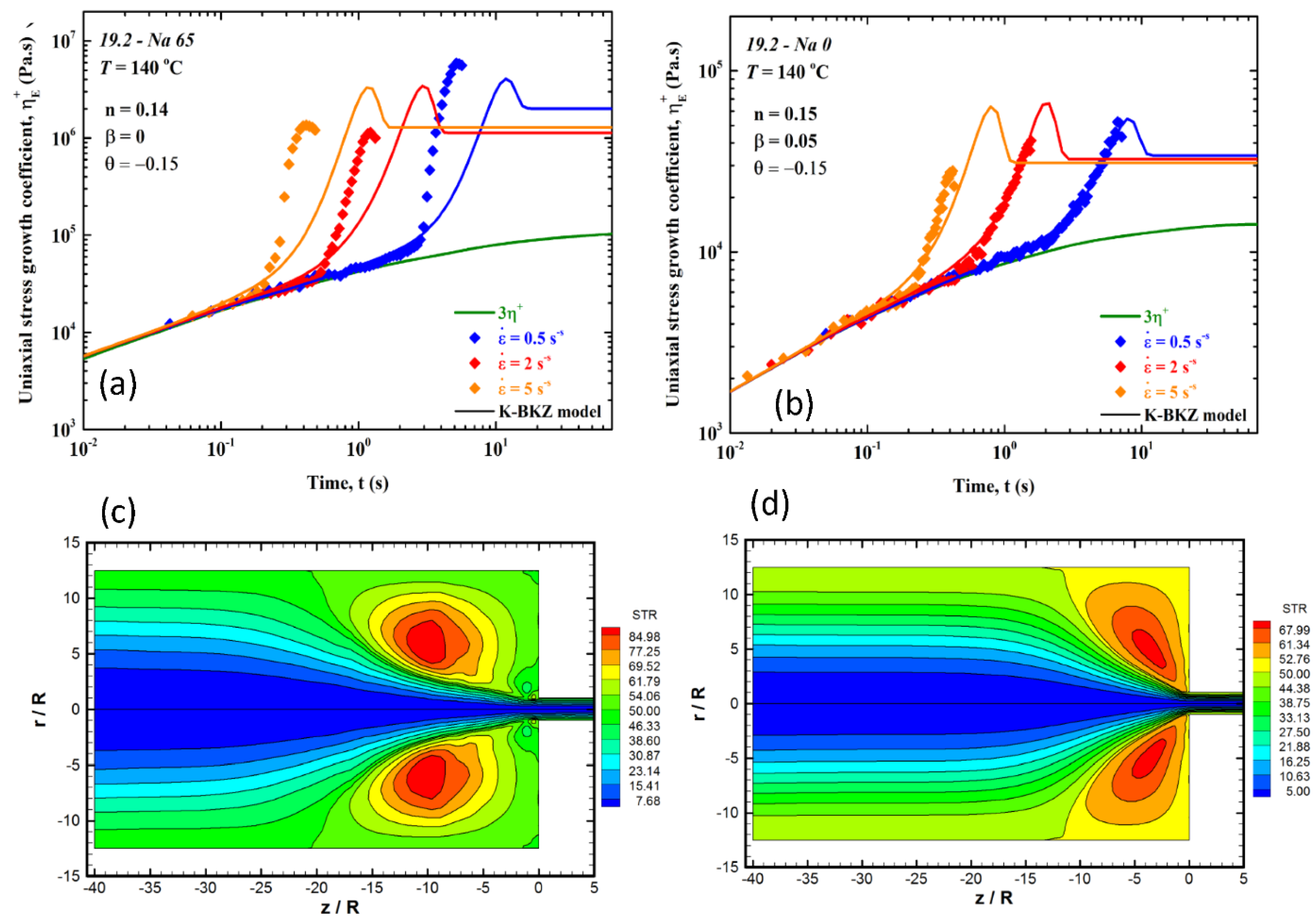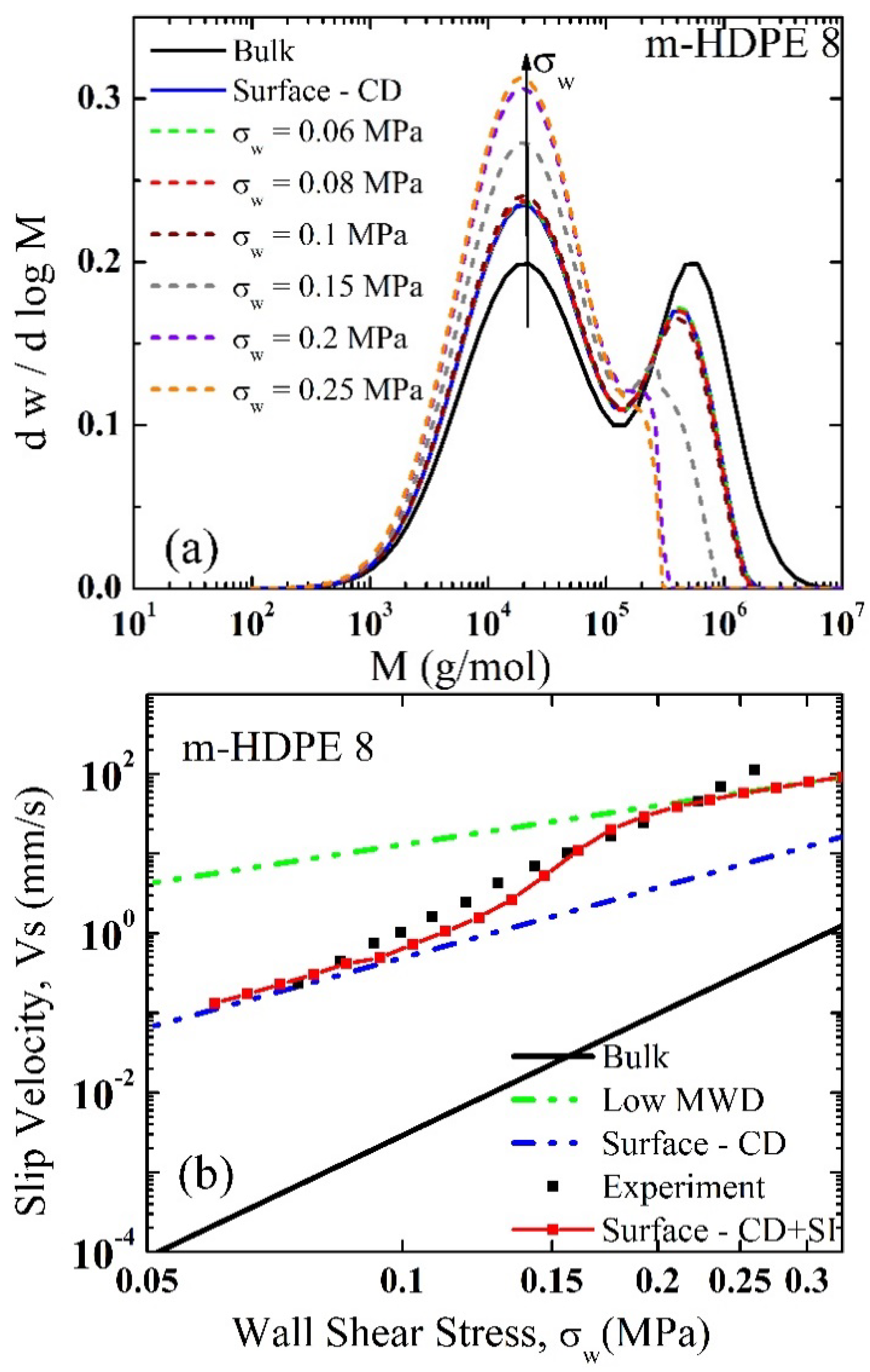Rheological Properties Related to Extrusion of Polyolefins
Abstract
1. Introduction
2. Parallel-Plate Rheometry: Effect of Temperature
3. Capillary Rheometry
3.1. Effect of Pressure on Viscosity
3.2. Entrance Pressure Significance
3.3. The Importance of Extensional Viscosity
4. Slip Effects
5. Conclusions
Author Contributions
Funding
Informed Consent Statement
Acknowledgments
Conflicts of Interest
References
- Dealy, J.M.; Wissbrun, K.F. Melt Rheology and Its Role in Plastics Processing—Theory and Applications; Springer Science & Business Media: Berlin, Germany, 1990. [Google Scholar]
- Tadmor, Z.; Gogos, C.G. Principles of Polymer Processing; John Wiley and Sons: New York, NY, USA, 2006. [Google Scholar]
- Macosco, C.W. Rheology: Principles, Measurements and Applications; John Wiley and Sons: New York, NY, USA, 1994. [Google Scholar]
- Bird, R.B.; Armstrong, R.C.; Hassager, O. Dynamics of Polymeric Liquids; John Wiley and Sons: New York, NY, USA, 1987. [Google Scholar]
- Bagley, E.B. End Corrections in the Capillary Flow of Polyethylene. J. Appl. Phys. 1957, 28, 624–627. [Google Scholar] [CrossRef]
- Cogswell, F.N. Measuring the Extensional Rheology of Polymer Melts. Trans. Soc. Rheol. 1972, 16, 383–403. [Google Scholar] [CrossRef]
- Cogswell, F.N. Polymer Melt Rheology—A Guide to Industrial Practice; John Wiley: New York, NY, USA, 1981. [Google Scholar]
- Binding, D. An approximate analysis for contraction and converging flows. J. Non Newton. Fluid Mech. 1988, 27, 173–189. [Google Scholar] [CrossRef]
- Binding, D. Further considerations of axisymmetric contraction flows. J. Non Newton. Fluid Mech. 1991, 41, 27–42. [Google Scholar] [CrossRef]
- Padmanabhan, M.; Macosco, C.W. Extensional Viscosity from Entrance Pressure Drop Measurements. Rheol. Acta 1997, 36, 144–151. [Google Scholar] [CrossRef]
- Laun, H.M. Pressure dependent viscosity and dissipative heating in capillary rheometry of polymer melts. Rheol. Acta 2003, 42, 295–308. [Google Scholar] [CrossRef]
- Laun, H.M. Capillary rheometry for polymer melts revisited. Rheol. Acta 2004, 43, 509–528. [Google Scholar] [CrossRef]
- Brochard, F.; De Gennes, P.G. Shear-dependent slippage at a polymer/solid interface. Langmuir 1992, 8, 3033–3037. [Google Scholar] [CrossRef]
- Hatzikiriakos, S.G.; Dealy, J.M. Wall Slip of Molten High-Density Polyethylene. II. Capillary Rheometer Studies. J. Rheol. 1992, 36, 703–741. [Google Scholar] [CrossRef]
- Brochard-Wyart, F.; Gay, C.; De Gennes, P.-G. Slippage of Polymer Melts on Grafted Surfaces. Macromolecules 1996, 29, 377–382. [Google Scholar] [CrossRef]
- Hatzikiriakos, S.G. Appropriate Boundary Conditions in the Flow of Molten Polymers. Int. Polym. Process. 2010, 25, 55–62. [Google Scholar] [CrossRef]
- Hatzikiriakos, S.G. Wall slip of molten polymers. Prog. Polym. Sci. 2012, 37, 624–643. [Google Scholar] [CrossRef]
- Hatzikiriakos, S.G. Slip mechanisms in complex fluid flows. Soft Matter 2015, 11, 7851–7856. [Google Scholar] [CrossRef]
- van Krevelen, D.W. Properties of Polymers; Elsevier: Amsterdam, The Netherlands, 1990. [Google Scholar]
- Couch, M.A.; Binding, D.M. High Pressure Capillary Rheometry of Polymer Fluids. Polymer 2000, 41, 6323–6334. [Google Scholar] [CrossRef]
- Liang, J.-Z. Pressure effect of viscosity for polymer fluids in die flow. Polymer 2001, 42, 3709–3712. [Google Scholar] [CrossRef]
- Cardinaels, R.; Van Puyvelde, P.; Moldenaers, P. Evaluation and comparison of routes to obtain pressure coefficients from high-pressure capillary rheometry data. Rheol. Acta 2006, 46, 495–505. [Google Scholar] [CrossRef]
- Park, H.E.; Lim, S.T.; Laun, H.M.; Dealy, J.M. Measurement of pressure coefficient of melt viscosity: Drag flow versus capillary flow. Rheol. Acta 2008, 47, 1023–1038. [Google Scholar] [CrossRef]
- Son, Y. Measurement of pressure dependence on the shear viscosity of polymer melts. J. Polym. Res. 2009, 16, 667–671. [Google Scholar] [CrossRef]
- Aho, J.; Syrjälä, S. Measurement of the Pressure Dependence of Viscosity of Polymer Melts Using a Back Pressure-Regulated Capillary Rheometer. J. Appl. Polym. Sci. 2010, 117, 1076–1084. [Google Scholar] [CrossRef]
- Koran, F.; Dealy, J.M. A high pressure sliding plate rheometer for polymer melts. J. Rheol. 1999, 43, 1279–1290. [Google Scholar] [CrossRef]
- Park, H.E.; Dealy, J.M. Effects of Pressure and Supercritical Fluids on the Viscosity of Polyethylene. Macromolecules 2006, 39, 5438–5452. [Google Scholar] [CrossRef]
- Sedláček, T.; Zatloukal, M.; Filip, P.; Boldizar, A.; Sáha, P. On the effect of pressure on the shear and elongational viscosities of polymer melts. Polym. Eng. Sci. 2004, 44, 1328–1337. [Google Scholar] [CrossRef]
- Santanach-Carreras, E.; El Kissi, N.; Piau, J.; Toussaint, F.; Nigen, S. Pressure effects on viscosity and flow stability of polyethylene melts during extrusion. Rheol. Acta 2005, 45, 209–222. [Google Scholar] [CrossRef]
- Duvdevani, I.J.; Klein, I. Analysis of Polymer Melt Flow in Capillaries Including Pressure Effects. Soc. Plast. Eng. Trans. J. 1967, 23, 4–45. [Google Scholar]
- Feigl, K.; Öttinger, H.C. The Flow of a LDPE Melt through an Axisymmetric Contraction: A Numerical Study and Comparison to Experimental Results. J. Rheol. 1994, 38, 847–874. [Google Scholar] [CrossRef]
- Barakos, G.; Mitsoulis, E. Numerical Simulation of Extrusion through Orifice Dies and Prediction of Bagley Correction for an IUPAC-LDPE Melt. J. Rheol. 1995a, 39, 193–209. [Google Scholar] [CrossRef]
- Barakos, G.; Mitsoulis, E. A convergence study for the numerical simulation of the IUPAC-LDPE extrusion experiments. J. Non Newton. Fluid Mech. 1995, 58, 315–329. [Google Scholar] [CrossRef]
- Béraudo, C.; Coupez, T.; Fortin, A.; Demay, Y.; Vergnes, B.; Agassant, J.-F. Viscoelastic Computations in 2-D Flow Geometries: Comparison with Experiments on Molten Polymers. In Proceedings of the 7th International Conference Rheology, Department of Chemical Engineering, Université Laval, Quebec City, Canada, 18–23 August 1996; Ait-Kadi, A., Dealy, J.M., James, D.F., Williams, M.C., Eds.; pp. 417–418. [Google Scholar]
- Guillet, J.; Revenue, P.; Béreaux, Y.; Clermont, J.-R. Experimental and Numerical Study of Entry Flow of Low-Density Polyethylene Melts. Rheol. Acta 1996, 35, 494–507. [Google Scholar] [CrossRef]
- Mitsoulis, E.; Hatzikiriakos, S.G. Bagley correction: The effect of contraction angle and its prediction. Rheol. Acta 2003, 42, 309–320. [Google Scholar] [CrossRef]
- Ansari, M.; Alabbas, A.; Hatzikiriakos, S.G.; Mitsoulis, E. Entry Flow of Polyethylene Melts in Tapered Dies. Int. Polym. Process. 2010, 25, 287–296. [Google Scholar] [CrossRef]
- Mitsoulis, E.; Hatzikiriakos, S.G.; Christodoulou, K.; Vlassopoulos, D. Sensitivity analysis of the Bagley correction to shear and extensional rheology. Rheol. Acta 1998, 37, 438–448. [Google Scholar] [CrossRef]
- Hatzikiriakos, S.G.; Mitsoulis, E. Excess pressure losses in the capillary flow of molten polymers. Rheol. Acta 1996, 35, 545–555. [Google Scholar] [CrossRef]
- Zuliki, M.; Tomković, T.; Hatzikiriakos, S.G. Capillary flow of sodium and zinc ionomers. Phys. Fluids 2020, 32, 023106. [Google Scholar] [CrossRef]
- Tomković, T.; Mitsoulis, E.; Hatzikiriakos, S.G. Contraction flow of ionomers and their corresponding copolymers: Ionic and hydrogen bonding effects. Phys. Fluids 2019, 31, 033102. [Google Scholar] [CrossRef]
- Tomković, T.; Mitsoulis, E.; Hatzikiriakos, S.G. Contraction flow of ionomers. J. Non Newton. Fluid Mech. 2018, 262, 131–141. [Google Scholar] [CrossRef]
- Zhang, Z.; Hatzikiriakos, S.G. Entry pressure correlations in capillary flow. Phys. Fluids 2020, 32, 073106. [Google Scholar] [CrossRef]
- Ramamurthy, A.V. Wall Slip in Viscous Fluids and Influence of Materials of Construction. J. Rheol. 1986, 30, 337–357. [Google Scholar] [CrossRef]
- Kalika, D.; Denn, M.M. Wall Slip and Extrudate Distortion in Linear Low-Density Polyethylene. J. Rheol. 1987, 31, 815–834. [Google Scholar] [CrossRef]
- Hatzikiriakos, S.G.; Dealy, J.M. Wall slip of molten high density polyethylene. I. Sliding plate rheometer studies. J. Rheol. 1991, 35, 497–523. [Google Scholar] [CrossRef]
- Münstedt, H.; Schmidt, M.; Wassner, E. Stick and slip phenomena during extrusion of polyethylene melts as investigated by laser-Doppler velocimetry. J. Rheol. 2000, 44, 413–427. [Google Scholar] [CrossRef]
- Robert, L.; DeMay, Y.; Vergnes, B. Stick-slip flow of high density polyethylene in a transparent slit die investigated by laser Doppler velocimetry. Rheol. Acta 2004, 43, 89–98. [Google Scholar] [CrossRef]
- Ebrahimi, M.; Konaganti, V.K.; Hatzikiriakos, S.G. Dynamic slip of polydisperse linear polymers using partitioned plate. Phys. Fluids 2018, 30, 030601. [Google Scholar] [CrossRef]
- Hénot, M.; Chennevière, A.; Drockenmuller, E.; Léger, L.; Restagno, F. Comparison of the Slip of a PDMS Melt on Weakly Adsorbing Surfaces Measured by a New Photobleaching-Based Technique. Macromolecules 2017, 50, 5592–5598. [Google Scholar] [CrossRef]
- Chenneviere, A.; Cousin, F.; Boue, F.; Drockenmuller, E.; Shull, K.R.; Leger, L.; Restagno, F. Direct Molecular Evidence of the Origin of Slip of Polymer Melts on Grafted Brushes. Macromolecules 2016, 49, 2348–2353. [Google Scholar] [CrossRef]
- Awati, K.; Park, Y.; Weisser, E.; Mackay, M.E. Wall slip and shear stresses of polymer melts at high shear rates without pressure and viscous heating effects. J. Non Newton. Fluid Mech. 2000, 89, 117–131. [Google Scholar] [CrossRef]
- Mackay, M.E.; Henson, D.J. The Effect of Molecular Weight and Temperature on the Slip of Polystyrene Melts at Low Stress Levels. J. Rheol. 1998, 42, 1505–1517. [Google Scholar] [CrossRef]
- Mhetar, V.; Archer, L.A. Slip in Entangled Polymer Melts: 1. General Features. Macromolecules 1998, 31, 8607–8616. [Google Scholar] [CrossRef]
- Mhetar, V.; Archer, L.A. Slip in Entangled Polymer Melts: 2. Effect of Surface Treatment. Macromolecules 1998, 31, 8617–8622. [Google Scholar] [CrossRef]
- Kazatchkov, I.B.; Hatzikiriakos, S.G.; Stewart, C.W. Extrude distortion in the capillary/slit extrusion of a molten polypropylene. Polym. Eng. Sci. 1995, 35, 1864–1871. [Google Scholar] [CrossRef]
- Mitsoulis, E.; Kazatchkov, I.B.; Hatzikiriakos, S.G. The Effect of Slip on the Flow of a Branched PP Melt: Visualisation Experiments and Simulations. Rheol. Acta 2005, 44, 418–426. [Google Scholar] [CrossRef]
- Kazatchkov, I.B.; Hatzikiriakos, S.G. Relaxation effects of slip in shear flow of linear molten polymers. Rheol. Acta 2009, 49, 267–274. [Google Scholar] [CrossRef]
- Rosenbaum, E.E.; Hatzikiriakos, S.G.; Stewart, C.W. Flow Implications in the Processing of Teflon Resins. Int. Polym. Proc. 1995, 10, 204–212. [Google Scholar] [CrossRef]
- Othman, N.; Jazrawi, B.; Mehrkhodavandi, P.; Hatzikiriakos, S.G. Wall slip and melt fracture of poly(lactides). Rheol. Acta 2011, 51, 357–369. [Google Scholar] [CrossRef]
- Chatzigiannakis, E.; Ebrahimi, M.; Wagner, M.H.; Hatzikiriakos, S.G. Wall slip of polyisobutylenes: Effect of molecular characteristics. Rheol. Acta 2016, 56, 85–94. [Google Scholar] [CrossRef]
- Ferrás, L.L.; Afonso, A.; Alves, M.; Nóbrega, J.M.; Pinho, F.T. Newtonian and viscoelastic fluid flows through an abrupt 1:4 expansion with slip boundary conditions. Phys. Fluids 2020, 32, 043103. [Google Scholar] [CrossRef]
- Azese, M.N. Measurement and characterization of slippage and slip-law using a rigorous analysis in dynamics of oscillating rheometer: Newtonian fluid. Phys. Fluids 2018, 30, 023103. [Google Scholar] [CrossRef]
- Allal, A.; Vergnes, B. Molecular design to eliminate sharkskin defect for linear polymers. J. Non Newton. Fluid Mech. 2007, 146, 45–50. [Google Scholar] [CrossRef]
- Hill, D.A.; Hasegawa, T.; Denn, M.M. On the Apparent Relation between Adhesive Failure and Melt Fracture. J. Rheol. 1990, 34, 891–918. [Google Scholar] [CrossRef]
- Ebrahimi, M.; Ansari, M.; Hatzikiriakos, S.G. Wall slip of polydisperse linear polymers using double reptation. J. Rheol. 2015, 59, 885–901. [Google Scholar] [CrossRef]
- Van Der Gucht, J.; Besseling, N.A.M.; Fleer, G.J. Surface Segregation in Polydisperse Polymer Melts. Macromolecules 2002, 35, 6732–6738. [Google Scholar] [CrossRef]
- Ebrahimi, M.; Ansari, M.; Inn, Y.W.; Hatzikiriakos, S.G. Surface fractionation effects on slip of polydisperse polymer melts. Phys. Fluids 2016, 28, 093101. [Google Scholar] [CrossRef]
- Rorrer, N.A.; Dorgan, J.R. Molecular-scale simulation of cross-flow migration in polymer melts. Phys. Rev. E 2014, 90, 052603. [Google Scholar] [CrossRef]
- Dorgan, J.R.; Rorrer, N.A. Flow induced migration in polymer melts—Theory and simulation. In AIP Conference Proceedings; AIP Publishing LLC: Melville, NY, USA, 2015; Volume 1662, p. 30005. [Google Scholar] [CrossRef]
- Rorrer, N.A.; Dorgan, J.R. Finding the Missing Physics: Mapping Polydispersity into Lattice-Based Simulations. Macromolecules 2014, 47, 3185–3191. [Google Scholar] [CrossRef]
- Schreiber, H.P.; Storey, S.H. Molecular fractionation in capillary flow of polymer fluids. J. Polym. Sci. Part. B Polym. Lett. 1965, 3, 723–727. [Google Scholar] [CrossRef]
- Schreiber, H.P.; Storey, S.H.; Bagley, E.B. Molecular Fractionation in the Flow of Polymeric Fluids. J. Rheol. 1996, 10, 275–297. [Google Scholar] [CrossRef]
- Shelby, M.D.; Caflisch, G.B. Shear field induced diffusion and molecular weight fractionation during polymer processing. Polym. Eng. Sci. 2004, 44, 1283–1294. [Google Scholar] [CrossRef]
- Musil, J.; Zatloukal, M. Experimental investigation of flow induced molecular weight fractionation during extrusion of HDPE polymer melts. Chem. Eng. Sci. 2011, 66, 4814–4823. [Google Scholar] [CrossRef]
- Musil, J.; Zatloukal, M. Experimental investigation of flow induced molecular weight fractionation phenomenon for two linear HDPE polymer melts having same Mn and Mw but different Mz and Mz+1 average molecular weights. Chem. Eng. Sci. 2012, 81, 146–156. [Google Scholar] [CrossRef]
- Musil, J.; Zatloukal, M. Flow Induced Molecular Weight Fractionation during Capillary Flow of Linear Polymer Melt. Recent Advances in Fluid Mechanics, Heat & Mass Transfer and Biology. In Proceedings of the 9th WSEAS International Conference on Fluids, Cambridge, MA, USA, 25–27 January 2012; pp. 162–167. [Google Scholar]
- Inn, Y.W. Melt fracture, wall slip, and flow-induced fractionation of bimodal polyethylenes. In Proceedings of the Novel Trends in Rheology VI; AIP Publishing, Melville, NY, USA, 28–29 July 2015; p. 030004. [Google Scholar]
- Inn, Y.W.; Sukhadia, A.M.; Deslauriers, P.J. Flow-Induced Fractionation of Bimodal Metallocene Polyethylene in Capillary Extrusion. In Proceedings of the Annual Technical Conference—ANTEC, Conference Proceedings, Las Vegas, NV, USA, 28–30 April 2014; pp. 1108–1111. [Google Scholar]
- Najm, M.; Hatzikiriakos, S.G. Flow-induced fractionation effects on slip of polydisperse polymer melts. Phys. Fluids 2020, 32, 073109. [Google Scholar] [CrossRef]
- Ansari, M.; Inn, Y.W.; Sukhadia, A.M.; DesLauriers, P.J.; Hatzikiriakos, S.G. Wall slip of HDPEs: Molecular weight and molecular weight distribution effects. J. Rheol. 2013, 57, 927–948. [Google Scholar] [CrossRef]
- Lou, Y.; Wu, G.; Feng, Y. Wall Slip Behaviour of Polymers Based on Molecular Dynamics at the Micro/Nanoscale and Its Effect on Interface Thermal Resistance. Polymer 2020, 12, 2182. [Google Scholar] [CrossRef]
- Stanciu, N.-V.; Stan, F.; Sandu, I.-L.; Fetecau, C.; Turcanu, A.-M. Thermal, Rheological, Mechanical, and Electrical Properties of Polypropylene/Multi-Walled Carbon Nanotube Nanocomposites. Polymer 2021, 13, 187. [Google Scholar] [CrossRef]




Publisher’s Note: MDPI stays neutral with regard to jurisdictional claims in published maps and institutional affiliations. |
© 2021 by the authors. Licensee MDPI, Basel, Switzerland. This article is an open access article distributed under the terms and conditions of the Creative Commons Attribution (CC BY) license (http://creativecommons.org/licenses/by/4.0/).
Share and Cite
Mitsoulis, E.; Hatzikiriakos, S.G. Rheological Properties Related to Extrusion of Polyolefins. Polymers 2021, 13, 489. https://doi.org/10.3390/polym13040489
Mitsoulis E, Hatzikiriakos SG. Rheological Properties Related to Extrusion of Polyolefins. Polymers. 2021; 13(4):489. https://doi.org/10.3390/polym13040489
Chicago/Turabian StyleMitsoulis, Evan, and Savvas G. Hatzikiriakos. 2021. "Rheological Properties Related to Extrusion of Polyolefins" Polymers 13, no. 4: 489. https://doi.org/10.3390/polym13040489
APA StyleMitsoulis, E., & Hatzikiriakos, S. G. (2021). Rheological Properties Related to Extrusion of Polyolefins. Polymers, 13(4), 489. https://doi.org/10.3390/polym13040489





